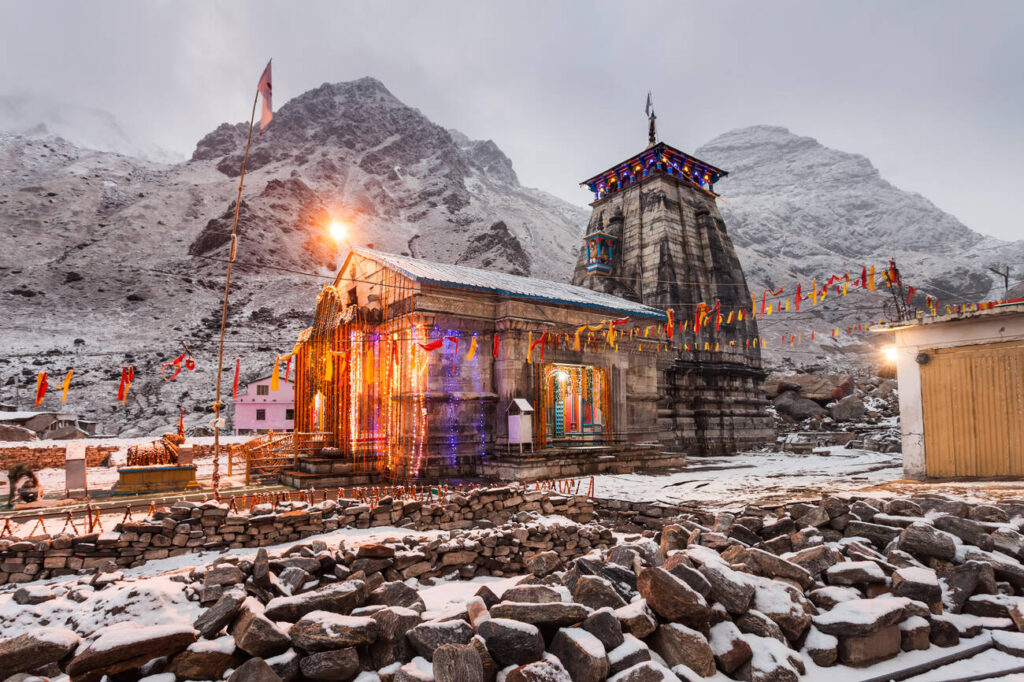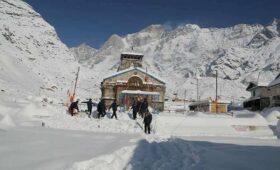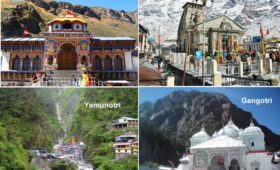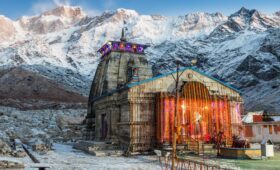In a surreal event of life, magic happens and you’re standing in the middle of the mighty Himalayas, surrounded by towering peaks and a peaceful silence that touches your soul; sound like a dream? Not much now. You can travel all of your Uttarakhand desires while exploring the holy spots with us. From the famous Kedarnath to Badrinath distance we will be covering all.

While you’ve just completed your darshan at Kedarnath, feeling the divine presence of Lord Shiva, and now it’s time for the next part of your journey—Badrinath, the sacred abode of Lord Vishnu. But then, you wonder: How far is Badrinath from Kedarnath? How do you get there? What’s the best way to travel? Don’t worry, this guide will help you understand the mostly asked question i.e Kedarnath to Badrinath distance, the travel options, and everything you need to know to make your journey smooth and memorable.
Kedarnath to Badrinath Distance – how far and how long?
The Kedarnath tod Badrinath distance is about 218 to 220 kilometers by road. While this might not sound too far, the journey takes around 9 to 11 hours due to the winding mountain roads. The route is filled with scenic landscapes, holy rivers, and small villages where devotion is a way of life.

There is no direct road between Kedarnath to Badrinath. You first need to trek 16 kilometres from Kedarnath to Gaurikund and then continue by road. If you’re looking for a faster and more comfortable way, you can also opt for a helicopter ride.
The best time to travel is between May and October, as the winter months bring heavy snowfall, making the roads difficult to navigate.
How can you travel from Kedarnath to Badrinath?
Since there’s no direct road, you have two main travel options.
Travelling by road is the most common option. First, you need to trek 16 kilometres from Kedarnath to Gaurikund. If trekking sounds too exhausting, you can hire a pony or palanquin. From Gaurikund, take a shared taxi or bus to Sonprayag, which is just 5 kilometres away. From there, you will travel through Guptkashi, Rudraprayag, and Joshimath before reaching Badrinath. The total road distance is about 218 kilometres and takes approximately 9 to 11 hours, excluding the trekking time.
Though the journey is long, the breathtaking views of the Himalayas and the spiritual energy along the route make every moment worthwhile.

If you want to skip the long road journey, taking a helicopter is the best option. You can take a helicopter from Kedarnath to Phata or Guptkashi. From there, you board another helicopter to Badrinath. The total travel time, including waiting periods, is about 2 to 3 hours. This is the fastest and most comfortable way to travel, though it is more expensive. If you’re short on time or prefer a hassle-free journey, this is the best option for you.
Important places on the journey
As you travel the Kedarnath to Badrinath distance, you will pass through several beautiful and spiritually significant places.
The first part of the journey is from Kedarnath to Gaurikund, a 16-kilometer trek. The path is steep but offers stunning views of the surrounding mountains. For those who cannot walk long distances, ponies and palanquins are available. Gaurikund is a key stop, where pilgrims take a dip in the natural hot spring before continuing their journey.
From Gaurikund, a short 5-kilometer drive takes you to Sonprayag. This is an important halt where travellers rest before heading further into the mountains. From Sonprayag, the road continues to Guptkashi, which is 30 kilometres away. Guptkashi is known for the ancient Vishwanath Temple, dedicated to Lord Shiva.
The next major stop is Rudraprayag, about 45 kilometres from Guptkashi. This is where the Alaknanda and Mandakini rivers meet, making it one of the five sacred confluences in Uttarakhand. Pilgrims often stop here for blessings before continuing their journey.
From Rudraprayag, the journey covers a long stretch of 115 kilometres to Joshimath. The road winds through mountains and valleys, offering mesmerizing views at every turn. Joshimath is the winter home of Lord Badrinath and is an important religious centre. The final part of the journey, from Joshimath to Badrinath, is about 45 kilometres. This last stretch is steep but incredibly beautiful. As you arrive, the majestic Badrinath Temple welcomes you with its divine aura.
Why is this journey so important?

The Kedarnath to Badrinath distance might be long, but this journey is more than just a physical trip. It is a spiritual transformation. Kedarnath Temple is dedicated to Lord Shiva, the god of destruction and transformation, while Badrinath Temple is dedicated to Lord Vishnu, the protector of the universe.
It is believed that visiting both these temples together helps in attaining Moksha, or liberation from the cycle of birth and death. The journey through the Himalayan landscape makes pilgrims feel closer to the divine. For many, this journey is physically challenging but spiritually rewarding. Every step brings a sense of peace and fulfilment.
Completing the Char Dham Yatra
Many pilgrims extend their journey beyond Kedarnath and Badrinath to complete the Char Dham Yatra, which includes Yamunotri, Gangotri, Kedarnath, and Badrinath. This is one of the most sacred pilgrimages in Hinduism.
There are different ways to complete this journey. The standard Char Dham Yatra takes around 10 to 12 days and includes all four temples with transport, accommodation, and meals. For those who prefer a faster journey, a helicopter Char Dham Yatra can be completed in 3 to 5 days. This option includes a VIP darshan at all four temples. If you have limited time, you can opt for the Do Dham Yatra, which covers Kedarnath and Badrinath in about 5 to 7 days.

Booking a Char Dham Yatra package makes the journey smoother, allowing you to focus on your spiritual experience.
The Kedarnath to Badrinath distance may be 218 to 220 kilometres, but the peace, devotion, and spiritual energy you will experience along the way cannot be measured in numbers. Whether you choose to travel by road or helicopter, this journey will fill your heart with faith and joy.
If you are planning your visit, consider booking a Char Dham Yatra package to make your pilgrimage hassle-free. This is more than just a journey; it is an experience that will stay with you forever. Start planning today and experience the spiritual magic of Kedarnath and Badrinath.
When is the best time to visit?
The best time to visit Kedarnath is during the months of May to June and September to November, when the weather is pleasant and the trek is manageable.
Is it safe to travel to Kedarnath?
Yes, It is generally safe to travel to, but it’s advisable to be alert about your belongings and avoid traveling during the monsoon season due to potential landslides.
What kind of weather can be expected?
Summer (May-June) is pleasant with temperate and cool climate. Monsoon (July-August) can be avoided as it brings heavy rainfall and potential landslides. Winter (November-February) is cold and snowy.
Where does the Yatri Registration for Kedarnath takes place?
You can register for the Kedarnath Yatra online
Link: https://badrinath-kedarnath.gov.in/Auth/LoginRegister/Login_Pilgrim.aspx
or through the Tourist Care Uttarakhand app
Link:https://play.google.com/store/apps/details?id=com.ethicsutdb.app&hl=en_IN&pli=1
Is the trek very difficult?
The trek is challenging, but manageable for most people, especially during the best time to visit.
What is the significance of Kedarnath?
Kedarnath is a sacred pilgrimage site for Hindus, and the temple is believed to be one of the 12 Jyotirlingas of Lord Shiva.




This article is super helpful and gave me a clear idea of what to expect on a Kedarnath trip. It’s definitely going to help me plan my journey better—can’t wait to experience it myself soon!
Helpful and informative! This article clearly explains the distance and travel options between Kedarnath and Badrinath—great for anyone planning the Char Dham Yatra.
This article shows Kedarnath is more than just a temple.